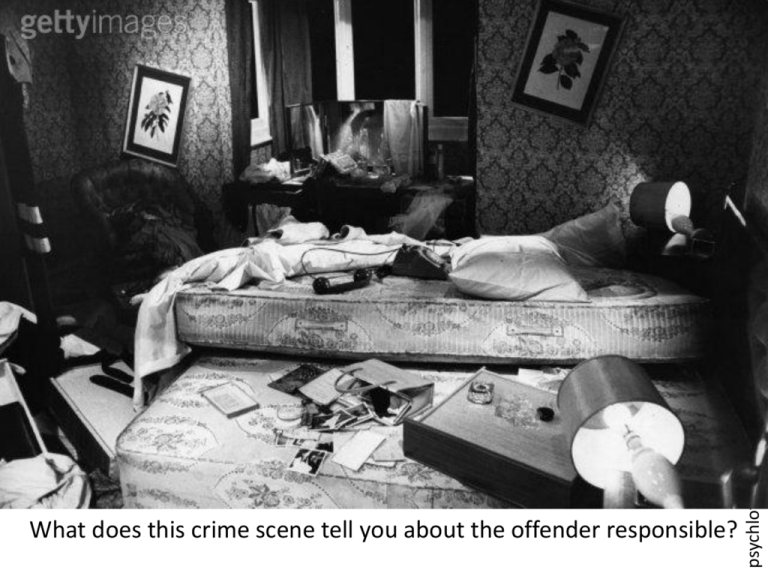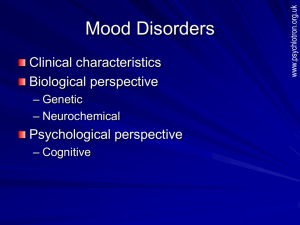Criminal Profiling Notes
advertisement

psychlotron.org.uk What does this crime scene tell you about the offender responsible? psychlotron.org.uk You live in a quiet neighborhood with lots of families. One day you come home and find this has happened to your front window and you find a baseball in your living room. Who do you think did it? Today’s session • • • You are learning to... Typological offender • profiling Geographic profiling • The 2 above are in addition to Inductive and deductive • Draw inferences from behavioural data Apply profiling principles to make judgements about offenders Compare and contrast psychological ideas psychlotron.org.uk You are learning about... Inductive Profiling • An example of this is a re-offending rapist whose target are white women, is not likely to be black, because crimes of the past that have been similar to this one have rarely crossed racial lines. However, these statements have been questioned and have experienced a lot of publicized drawbacks. psychlotron.org.uk • Inductive profiling involves assuming that when a criminal commits a crime, he or she will have a similar background and motive to others who have committed a similar crime. Deductive Profiling A deductive profile is set up based on the offender's actions before, during and after committing the crime. For example, if the murderer used a makeshift weapon, investigators are then able to deduce that the crime was probably spontaneous. psychlotron.org.uk • Deductive profiling involves a process that avoids generalizations and averages. This method involves intently studying suspects in extreme detail and adapting findings in which new evidence surfaces. • Serial killers are also known to stick within their 'comfort zone', for example, their own neighborhood, before traveling further as their sense of power and domination heightens. A serial killer often leaves behind a signature or trademark of their work that is usually unnecessary, but emotionally fulfills the killer. There are usually also similar aspects, which will link the crimes together, for eg. the method of murder or the victims may all have some form of similarity. Profilers use this to trace and link crimes committed earlier together. psychlotron.org.uk Serial Killers Two important ideas • Behavioural evidence – Things that tells us how an offender went about committing a crime • Criminal consistency psychlotron.org.uk – The idea that a person’s behaviour at a crime scene is consistent with their behaviour in other contexts Typological offender profiling • Developed by the US Federal Bureau of Investigation (FBI) in the 1970s and 1980s. • Key ideas: • Generally used in cases of serial violence against strangers esp. sexual or ‘bizarre’ psychlotron.org.uk – There are different types of offender – Behavioural evidence can tell us which type of offender committed a crime(violent, rape, murder) – Knowing an offender’s type allows us to predict other things about him Problems with typological profiling – Assumptions about stable types – Incomplete data – Subjective judgements – Small and unusual sample – Validity of methodology – Narrative & anecdotal evidence psychlotron.org.uk • What problems can you identify with the FBI’s approach to offender profiling? Data assimilation Data compiled from police reports, post mortems, crime scene photos etc. Crime classification Profilers decide whether the crime scene is organised or disorganised Profile generation Offender’s physical, demographic and behavioural characteristics Crime reconstruction Hypotheses about crime sequence, offender & victim behaviour etc. psychlotron.org.uk FBI profiling process Organised Disorganised General approach Planned and controlled Unplanned and chaotic Weapons Brought to the scene Improvised Evidence Destroyed or removed Left at scene Victim Attempts to control Little attempt at control Offender Unknown to victim Socially & sexually competent Normal/high intelligence Angry/depressed Possibly known to victim Socially & sexually inept Low intelligence Anxious/psychotic psychlotron.org.uk Types of crime scene Profile these crime scenes • Use the evidence to construct a profile – Organised or disorganised – Behavioural evidence – Known characteristics of serial offenders – Tell the story of the crime – Describe the person responsible psychlotron.org.uk • Your profile should… psychlotron.org.uk psychlotron.org.uk psychlotron.org.uk Compare and contrast… – Purpose – Assumptions – Use of categories/types – Types of crime applicable – Evidence base psychlotron.org.uk • How are geographical and typological offender profiling similar and different? psychlotron.org.uk • Describe and evaluate one or more approaches to offender profiling.







